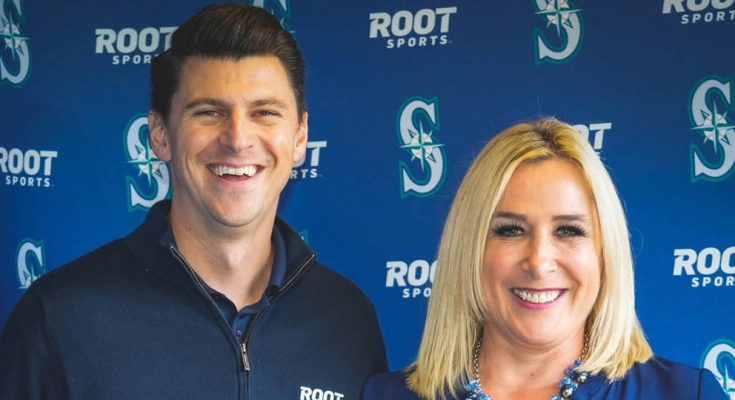Seattle Mariners color commentator Angie Mentink has long been a recognizable and familiar presence for fans of the franchise. Her association with the team, going back to the early 2000s through her work with Root Sports and Fox Sports Northwest, has given her a well-established place in the broadcast booth. Her legacy as a trailblazer in the Pacific Northwest sports world is built on decades of involvement in athletics, particularly as a standout with the Washington Huskies. For over 25 years, she has contributed to the broader baseball and sports media ecosystem in ways that are difficult to dismiss or overlook. However, when evaluating her current performance as a color commentator specifically, it’s important to approach the subject with clarity and objectivity. The goal here is not to diminish her background, passion, or commitment, but to provide an honest assessment of her broadcasting capabilities in the live, in-game context of Major League Baseball.
Color commentary is a role that requires a specialized set of skills. It’s not just about knowledge of the game or familiarity with players and trends. Rather, it demands the ability to communicate real-time insights in a manner that complements the play-by-play announcer, enhances the viewing experience, and educates or engages the audience without distraction. A good color commentator brings perspective grounded in playing experience or deep analytical understanding. They explain the subtleties of decisions on the field, interpret player behavior, and contextualize moments based on the rhythm and nuance of the game. It’s a delicate balance of knowing when to speak and when to allow the action to breathe.
Mentink, for all her experience in and around baseball, at times struggles with this balance. One noticeable pattern is her tendency to drift away from the action on the field to share personal stories that lack connection to the game. This includes anecdotes about her children, parenting challenges, or even pop culture references like Sesame Street. While such commentary might occasionally offer a humanizing or humorous diversion, it can feel jarring or misplaced during key moments in a close or competitive game. Viewers tune in not only to watch the action unfold but to receive meaningful commentary that enhances their understanding of what’s happening between the lines. When the content delivered veers too far from that core mission, it becomes a distraction.
Moreover, Mentink often dominates the broadcast with long-form musings and verbal tangents that overshadow the play-by-play announcer’s responsibilities. In doing so, the natural rhythm of the broadcast—one in which the play-by-play provides structure and pacing while the color commentator offers intermittent analytical insights—is disrupted. Good booth chemistry requires deference, mutual awareness, and an ability to support rather than override one another’s strengths. While her enthusiasm is never in question, her volume and verbosity at times work against the coherence and fluidity of the broadcast.
Another aspect to consider is her lack of Major League Baseball playing experience. While she certainly possesses a deep love for the game and has worked in it professionally for decades, including as a former professional softball player, this background does not always translate directly into a nuanced understanding of the pressures and decision-making processes unique to MLB-level competition. Major League Baseball is a game of adjustments, subtle psychological battles, and intricate strategies. Commentators who’ve lived through the grind of a 162-game season, managed late-inning bullpen decisions, or faced elite-level pitching often bring a level of authenticity and credibility that’s difficult to replicate from the outside.
This difference becomes especially clear when comparing Mentink’s commentary to that of previous Mariners analysts such as Mike Blowers, Dave Henderson, and Ron Fairly. These individuals had long MLB careers and brought that insight into the booth, often in concise, targeted contributions. Blowers, in particular, was known for his ability to read swings, predict pitch sequences, and evaluate matchups in a manner that brought viewers closer to the action. Henderson and Fairly also had a gift for boiling complex ideas down into digestible, often entertaining, commentary that never overshadowed the play-by-play narrative.
It’s worth noting that Mentink is not the only broadcaster currently facing these challenges. Ryan Rowland-Smith, another Mariners color commentator, is a former MLB pitcher with a relatively brief career. While he offers strong knowledge from a pitcher’s perspective, his limited time in the majors does occasionally limit the depth of his insight, especially compared to long-tenured veterans. He does, however, often strike a better balance between personal perspective and analytical commentary, though even he sometimes falls short in providing the level of depth that longtime viewers crave.
The truth is, many teams around the league are investing in high-level broadcasting talent—often composed of former MLB players who not only played the game but can also articulate it clearly and effectively to a broad audience. That’s where someone like Dave Valle, a former Mariners catcher with over a decade of playing experience, stands out as a more natural fit for the full-time color commentator role. Valle has demonstrated an ability to speak to the inner workings of the game without drifting off-topic. He understands both the player mindset and the viewer’s expectations. As a catcher, he also offers a unique vantage point of the game—one that encompasses both offense and defense, pitching strategy, and the psychology of game management.
It is entirely fair to have hoped for Angie Mentink’s success in this role. She has certainly paid her dues, and her passion for the Mariners is unmistakable. Her promotion to the color commentator’s chair felt like a natural extension of her long service to the organization. She is a respected figure in the region and brings undeniable energy to each broadcast. However, the skills that make one effective in pre-game studio shows or as a sideline reporter do not always translate cleanly to in-game color commentary. The booth requires a different kind of discipline—one focused on restraint, timing, and an analytical edge tailored to the pace and tenor of the game.
The 2025 season has made this transition especially apparent, as longtime commentator Mike Blowers is no longer present. His absence has left a vacuum that Mentink has tried to fill, but it’s clear that Blowers’ particular mix of insight, brevity, and game awareness is difficult to replicate. His experience and chemistry with the play-by-play team allowed the broadcast to flow naturally. Without him, the product has felt disjointed at times, and Mentink’s overreliance on personality-driven commentary only compounds that issue.
This is not to say that Mentink does not have a role within the Mariners’ broadcasting structure. In fact, she has demonstrated considerable skill as a studio analyst. When given time to prepare segments, interview players, or break down specific storylines in a controlled setting, she excels. Her charisma, deep connection to the franchise, and storytelling ability are assets in that context. Studio analysis allows more freedom to infuse personal narratives or anecdotes, especially when there’s room to tie those back into baseball themes. The timing constraints and play-by-play dependencies of in-game commentary don’t leave the same space for that kind of storytelling.
Angie Mentink has also become a symbolic figure in the Pacific Northwest sports community, and that reputation deserves to be preserved and celebrated. But broadcasting is not about symbolism—it’s about performance. Her resume speaks for itself in terms of longevity and contribution, but performance in the booth is measured differently. It’s measured by clarity, relevance, timing, insight, and how much value the color analyst adds to each pitch, swing, and play on the field.
As the Mariners continue to evolve on the field, the broadcasting team must evolve alongside them. Fans deserve coverage that matches the intelligence, competitiveness, and sophistication of today’s game. That might mean making tough choices about who is best suited for which role. It might also mean allowing Mentink to thrive in the settings that showcase her strengths rather than forcing her into a position where the fit isn’t natural. The ultimate goal should be to deliver the most informative, engaging, and enjoyable broadcast experience possible—and that starts with placing the right voices in the right roles.



